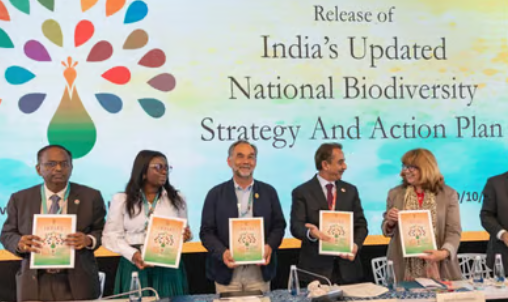India’s National Biodiversity Strategy and Action Plan Unveiled
India presented its National Biodiversity Strategy and Action Plan (NBSAP) at the UN conference on biodiversity in Cali, Colombia. This submission aligns with the Kunming-Montreal Global Biodiversity Framework (KM-GBF). The KM-GBF aims to halt biodiversity loss by 2030, with 196 countries committed to achieving a nature-positive world.
Key Themes of the KM-GBF
The KM-GBF is structured around three main themes:
- Reducing threats to biodiversity.
- Meeting people’s needs through sustainable use.
- Implementing tools and solutions for mainstreaming biodiversity.
India’s NBSAP outlines 23 targets that reflect these themes.
India’s Biodiversity Overview
India is home to about 8% of the world’s known plant and animal species. It includes:
- 3,532 species of fish.
- 450 amphibian species.
- 738 reptilian species.
- 1,346 bird species.
- 436 mammal species.
This rich biodiversity underscores the importance of effective conservation strategies.
Goals of the NBSAP
The NBSAP aims to address various national challenges, including the water crisis, Food insecurity, Unsustainable livelihoods, Pollution, Human-wildlife interactions, Emerging diseases, and Disaster risks. It focuses on the sustainable use of biological resources and the equitable sharing of benefits.
Restoration of Ecosystems
One of India’s primary goals is to restore at least 30% of degraded ecosystems. This includes Terrestrial, Inland water, Marine, and coastal ecosystems. Restoration enhances biodiversity and improves ecosystem functions.
Targets Addressing Biodiversity Threats
Eight of the 23 targets focus on reducing biodiversity threats. These include Land and sea use changes, Pollution management, Combating species overexploitation, Climate change mitigation, Managing invasive alien species, and Ecosystem restoration. Each target is designed to tackle specific challenges.
Invasive Alien Species Management
India plans to manage invasive alien species through:
- Elimination and reduction strategies
- Monitoring introduction pathways
- Establishing a national database on invasive species.
The action plan identifies trade and farming of exotic species as key introduction pathways.
Financial Support for Biodiversity
To achieve its targets requires substantial financial backing. The government has conducted biodiversity expenditure reviews. The average annual expenditure from 2017-18 to 2021-22 was approximately Rs 32,207.13 crore. For the 2024-25 to 2029-30 period, the projected annual average expenditure is Rs 81,664.88 crore. A comprehensive assessment of financial needs is essential for effective implementation.
Framework for Action
The NBSAP provides a structured framework for biodiversity conservation. It promotes:
- Sustainable resource use.
- Fair benefit-sharing.
- Collaboration between national and global conservation agendas.
This framework is crucial for addressing India’s unique biodiversity challenges and contributing to global efforts.
Month: Current Affairs - November, 2024
Category: India Nation & States Current Affairs








